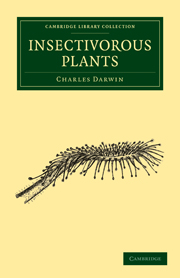Book contents
- Frontmatter
- Contents
- CHAPTER I DROSERA ROTUNDIFOLIA, OR THE COMMON SUN-DEW
- CHAPTER II THE MOVEMENTS OF THE TENTACLES FROM THE CONTACT OF SOLID BODIES
- CHAPTER III AGGREGATION OF THE PROTOPLASM WITHIN THE CELLS OF THE TENTACLES
- CHAPTER IV THE EFFECTS OF HEAT ON THE LEAVES
- CHAPTER V THE EFFECTS OF NON-NITROGENOUS AND NITROGENOUS ORGANIC FLUIDS ON THE LEAVES
- CHAPTER VI THE DIGESTIVE POWER OF THE SECRETION OF DEOSERA
- CHAPTER VII THE EFFECTS OF SALTS OF AMMONIA
- CHAPTER VIII THE EFFECTS OF VARIOUS OTHER SALTS, AND ACIDS, ON THE LEAVES
- CHAPTER IX THE EFFECTS OF CERTAIN ALKALOID POISONS, OTHER SUBSTANCES AND VAPOURS
- CHAPTER X ON THE SENSITIVENESS OF THE LEAVES, AND ON THE LINES OF TRANSMISSION OF THE MOTOR IMPULSE
- CHAPTER XI RECAPITULATION OF THE CHIEF OBSERVATIONS ON DROSERA ROTUNDIFOLIA
- CHAPTER XII ON THE STRUCTURE AND MOVEMENTS OF SOME OTHER SPECIES OF DROSERA
- CHAPTER XIII DIONÆA MUSCIPULA
- CHAPTER XIV ALDROVANDA VESICULOSA
- CHAPTER XV DROSOPHYLLUM — RORIDULA — BYBLIS — GLANDULAR HAIRS OF OTHER PLANTS — CONCLUDING REMARKS ON THE DROSERACEÆ
- CHAPTER XVI PINGUICULA
- CHAPTER XVII UTRICULARIA
- CHAPTER XVIII UTRICULARIA (continued)
- ERRATA
- INDEX
CHAPTER IV - THE EFFECTS OF HEAT ON THE LEAVES
Published online by Cambridge University Press: 29 August 2010
- Frontmatter
- Contents
- CHAPTER I DROSERA ROTUNDIFOLIA, OR THE COMMON SUN-DEW
- CHAPTER II THE MOVEMENTS OF THE TENTACLES FROM THE CONTACT OF SOLID BODIES
- CHAPTER III AGGREGATION OF THE PROTOPLASM WITHIN THE CELLS OF THE TENTACLES
- CHAPTER IV THE EFFECTS OF HEAT ON THE LEAVES
- CHAPTER V THE EFFECTS OF NON-NITROGENOUS AND NITROGENOUS ORGANIC FLUIDS ON THE LEAVES
- CHAPTER VI THE DIGESTIVE POWER OF THE SECRETION OF DEOSERA
- CHAPTER VII THE EFFECTS OF SALTS OF AMMONIA
- CHAPTER VIII THE EFFECTS OF VARIOUS OTHER SALTS, AND ACIDS, ON THE LEAVES
- CHAPTER IX THE EFFECTS OF CERTAIN ALKALOID POISONS, OTHER SUBSTANCES AND VAPOURS
- CHAPTER X ON THE SENSITIVENESS OF THE LEAVES, AND ON THE LINES OF TRANSMISSION OF THE MOTOR IMPULSE
- CHAPTER XI RECAPITULATION OF THE CHIEF OBSERVATIONS ON DROSERA ROTUNDIFOLIA
- CHAPTER XII ON THE STRUCTURE AND MOVEMENTS OF SOME OTHER SPECIES OF DROSERA
- CHAPTER XIII DIONÆA MUSCIPULA
- CHAPTER XIV ALDROVANDA VESICULOSA
- CHAPTER XV DROSOPHYLLUM — RORIDULA — BYBLIS — GLANDULAR HAIRS OF OTHER PLANTS — CONCLUDING REMARKS ON THE DROSERACEÆ
- CHAPTER XVI PINGUICULA
- CHAPTER XVII UTRICULARIA
- CHAPTER XVIII UTRICULARIA (continued)
- ERRATA
- INDEX
Summary
In my observations on Drosera rotundifolia, the leaves seemed to be more quickly inflected over animal substances, and to remain inflected for a longer period during very warm than during cold weather. I wished, therefore, to ascertain whether heat alone would induce inflection, and what temperature was the most efficient. Another interesting point presented itself, namely, at what degree life was extinguished; for Drosera offers unusual facilities in this respect, not in the loss of the power of inflection, but in that of subsequent re-expansion, and more especially in the failure of the protoplasm to become aggregated, when the leaves after being heated are immersed in a solution of carbonate of ammonia.
My experiments were tried in the following manner. Leaves were cut off, and this does not in the least interfere with their powers; for instance, three cut-off leaves, with bits of meat placed on them, were kept in a damp atmosphere, and after 23 hrs. closely embraced the meat both with their tentacles and blades; and the protoplasm within their cells was well aggregated. Three ounces of doubly distilled water was heated in a porcelain vessel, with a delicate thermometer having a long bulb obliquely suspended in it. The water was gradually raised to the required temperature by a spirit-lamp moved about under the vessel; and in all cases the leaves were continually waved for some minutes close to the bulb. They were then placed in cold water, or in a solution of carbonate of ammonia. […]
- Type
- Chapter
- Information
- Insectivorous Plants , pp. 66 - 75Publisher: Cambridge University PressPrint publication year: 2009First published in: 1875



